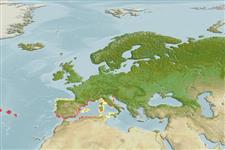>
Gobiesociformes (Clingfishes) >
Gobiesocidae (Clingfishes and singleslits) > Lepadogastrinae
Etymology: Apletodon: Greek, aplatos, apletos = terrible + Greek, odous = teeth (Ref. 45335).
Environment: milieu / climate zone / depth range / distribution range
นิเวศวิทยา
เกี่ยวกับทะเล,น้ำเค็ม สัตว์น้ำหน้าดิน; ระดับความลึก 2 - 19 m (Ref. 28715). Subtropical; 45°N - 36°N, 32°W - 14°E
Mediterranean Sea: Rovinj and Premantura (Istria, northern Adriatic Sea), around Elba (Italy), Ibiza (Baleares), Banyuls-sur-Mer (southern France). Northeast Atlantic: Azores.
ขนาด / น้ำหนัก / Age
Maturity: Lm ? range ? - ? cm
Max length : 2.7 cm SL เพศผู้/กระเทย; (Ref. 28715)
Juveniles about 1-2 cm SL are often observed in association with sea urchins and in beds of Posidonia oceanica. Adults found hidden under stones covered with red calcareous algae and empty shells of mussels near Posidonia and Cymodocea nodosa beds. Among Posidonia, the species is often sympatric with Opeatogenys gracilis (Ref. 28715).
Life cycle and mating behavior
วัยเจริญพันธุ์ | การสืบพันธุ์ | การวางไข่ | เซลสืบพันธ์ของเพศเมีย(ไข่) | ความดกของไข่ | ตัวอ่อน
Hofrichter, R. and R.A. Patzner, 1997. A new species of Apletodon from the Mediterranean Sea and the eastern Atlantic with notes on the differentiation between Apletodon and Diplecogaster species (Pisces: Teleostei: Gobiesociformes: Gobiesocidae). Senckenbergiana biol. 77(1):15-22. (Ref. 28715)
IUCN Red List Status (Ref. 130435)
Threat to humans
Harmless
Human uses
ข้อมูลเพิ่มเติม
ชื่อสามัญชื่อพ้องกลไกการเผาผลาญพลังงานผู้ล่าการศึกษาเกี่ยวกับผลกระทบของสารประกอบทางเคมีที่เป็นอันตรายต่อสิ่งมีชีวิต ประชากร และสิ่งแวดล้อมการสืบพันธุ์วัยเจริญพันธุ์การวางไข่การรวมกลุ่มวางไข่ความดกของไข่เซลสืบพันธ์ของเพศเมีย(ไข่)Egg development
Age/Size
การเจริญเติบโต
Length-weight
Length-length
Length-frequencies
ความยาวต่างๆ
สัณฐานวิทยา
ตัวอ่อน
พลวัตของสัตว์น้ำวัยอ่อน
การทดแทนที่
อุดมสมบรูณ์
BRUVS
อ้างอิงการเพาะเลี้ยงสัตว์น้ำประวัติการเพาะเลี้ยงสัตว์น้ำสายพันธุ์พันธุศาสตร์ElectrophoresesอัตราพันธุกรรมโรคการแปรรูปNutrientsMass conversion
ผู้ร่วมมือรูปภาพหลายรูปStamps, Coins Misc.เสียงปลามีพิษ เช่น ปลาปักเป้าความเร็วรูปแบบการว่ายน้ำพื้นที่เหงือกOtolithsสมองวิสัยทัศน์
เครื่องมือ
Special reports
Download XML
แหล่งที่มาจากอินเตอร์เน็ต
Estimates based on models
Preferred temperature (Ref.
123201): 17.6 - 19.2, mean 18.7 °C (based on 109 cells).
Phylogenetic diversity index (Ref.
82804): PD
50 = 0.5156 [Uniqueness, from 0.5 = low to 2.0 = high].
Bayesian length-weight: a=0.00513 (0.00202 - 0.01305), b=3.11 (2.89 - 3.33), in cm total length, based on LWR estimates for this (Sub)family-body shape (Ref.
93245).
ระดับชั้นอาหาร (Ref.
69278): 3.1 ±0.5 se; based on size and trophs of closest relatives
ความสามารถในการกลับคืนสู่ปกติ (Ref.
120179): ความสูง, เวลาต่ำสุดที่จะทำให้ประชากรเพิ่มขึ้นเป็น 2 เท่าใช้เวลาน้อยกว่า 15 เดือน (Preliminary K or Fecundity.).
Fishing Vulnerability (Ref.
59153): Low vulnerability (10 of 100).
